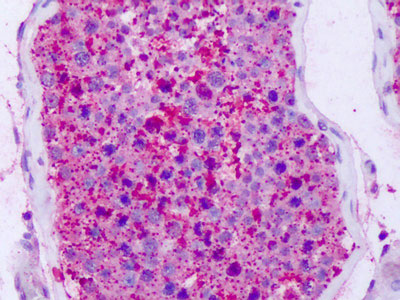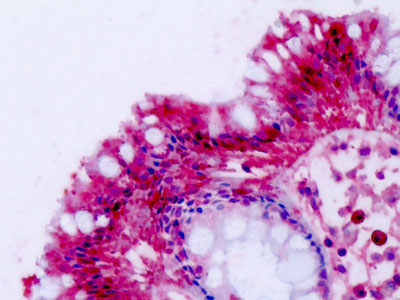NPFF2 / NPFFR2 Antibody (C-Terminus)
Rabbit Polyclonal Antibody
- SPECIFICATION
- CITATIONS
- PROTOCOLS
- BACKGROUND

Application
| IHC-P |
|---|---|
| Primary Accession | Q9Y5X5 |
| Reactivity | Human |
| Host | Rabbit |
| Clonality | Polyclonal |
| Calculated MW | 60kDa |
| Dilution | IHC-P (4-7 µg/ml) |
| Gene ID | 10886 |
|---|---|
| Other Names | Neuropeptide FF receptor 2, G-protein coupled receptor 74, G-protein coupled receptor HLWAR77, Neuropeptide G-protein coupled receptor, NPFFR2, GPR74, NPFF2, NPGPR |
| Target/Specificity | Human NPFFR2. BLAST analysis of the peptide immunogen showed no homology with other human proteins. |
| Reconstitution & Storage | Long term: -70°C; Short term: +4°C |
| Precautions | NPFF2 / NPFFR2 Antibody (C-Terminus) is for research use only and not for use in diagnostic or therapeutic procedures. |
| Name | NPFFR2 (HGNC:4525) |
|---|---|
| Synonyms | GPR74, NPFF2, NPGPR |
| Function | Receptor for NPAF (A-18-F-amide) and NPFF (F-8-F-amide) neuropeptides, also known as morphine-modulating peptides. Can also be activated by a variety of naturally occurring or synthetic FMRF-amide like ligands. This receptor mediates its action by association with G proteins that activate a phosphatidylinositol-calcium second messenger system. |
| Cellular Location | Cell membrane; Multi-pass membrane protein |
| Tissue Location | Isoform 1 is abundant in placenta. Relatively highly expressed in thymus, testis, and small intestine. Expressed at low levels in several tissues including spleen, prostate, brain, heart, ovary, colon, kidney, lung, liver and pancreas and not expressed in skeletal muscle and leukocytes. Isoform 2 expression is highest in placenta (but at relatively low level compared to isoform 1). Very low level of expression in numerous tissues including adipose tissue and many brain regions. Isoform 3 is expressed in brain and heart and, at lower levels, in kidney, liver, lung and pancreas |
| Volume | 50 µl |

Thousands of laboratories across the world have published research that depended on the performance of antibodies from Abcepta to advance their research. Check out links to articles that cite our products in major peer-reviewed journals, organized by research category.
info@abcepta.com, and receive a free "I Love Antibodies" mug.
Provided below are standard protocols that you may find useful for product applications.
Background
Receptor for NPAF (A-18-F-amide) and NPFF (F-8-F-amide) neuropeptides, also known as morphine-modulating peptides. Can also be activated by a variety of naturally occurring or synthetic FMRF-amide like ligands. This receptor mediates its action by association with G proteins that activate a phosphatidylinositol- calcium second messenger system.
References
Cikos S.,et al.Biochem. Biophys. Res. Commun. 256:352-356(1999).
Elshourbagy N.A.,et al.J. Biol. Chem. 275:25965-25971(2000).
Bonini J.A.,et al.J. Biol. Chem. 275:39324-39331(2000).
Parker R.M.C.,et al.Brain Res. Mol. Brain Res. 77:199-208(2000).
Liu Q.,et al.Submitted (DEC-2000) to the EMBL/GenBank/DDBJ databases.
If you have used an Abcepta product and would like to share how it has performed, please click on the "Submit Review" button and provide the requested information. Our staff will examine and post your review and contact you if needed.
If you have any additional inquiries please email technical services at tech@abcepta.com.













 Foundational characteristics of cancer include proliferation, angiogenesis, migration, evasion of apoptosis, and cellular immortality. Find key markers for these cellular processes and antibodies to detect them.
Foundational characteristics of cancer include proliferation, angiogenesis, migration, evasion of apoptosis, and cellular immortality. Find key markers for these cellular processes and antibodies to detect them. The SUMOplot™ Analysis Program predicts and scores sumoylation sites in your protein. SUMOylation is a post-translational modification involved in various cellular processes, such as nuclear-cytosolic transport, transcriptional regulation, apoptosis, protein stability, response to stress, and progression through the cell cycle.
The SUMOplot™ Analysis Program predicts and scores sumoylation sites in your protein. SUMOylation is a post-translational modification involved in various cellular processes, such as nuclear-cytosolic transport, transcriptional regulation, apoptosis, protein stability, response to stress, and progression through the cell cycle. The Autophagy Receptor Motif Plotter predicts and scores autophagy receptor binding sites in your protein. Identifying proteins connected to this pathway is critical to understanding the role of autophagy in physiological as well as pathological processes such as development, differentiation, neurodegenerative diseases, stress, infection, and cancer.
The Autophagy Receptor Motif Plotter predicts and scores autophagy receptor binding sites in your protein. Identifying proteins connected to this pathway is critical to understanding the role of autophagy in physiological as well as pathological processes such as development, differentiation, neurodegenerative diseases, stress, infection, and cancer.



